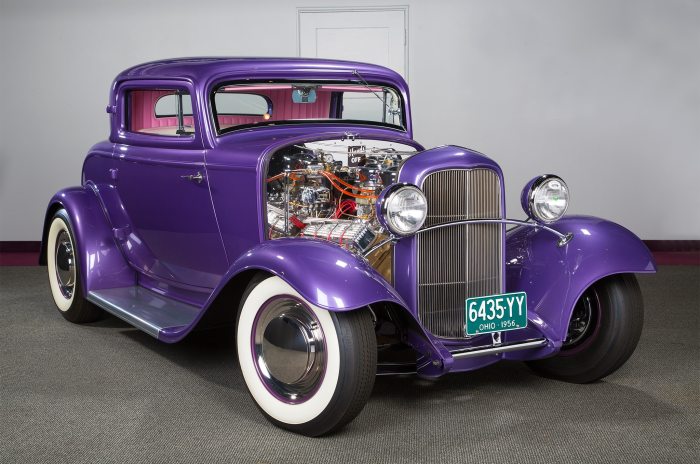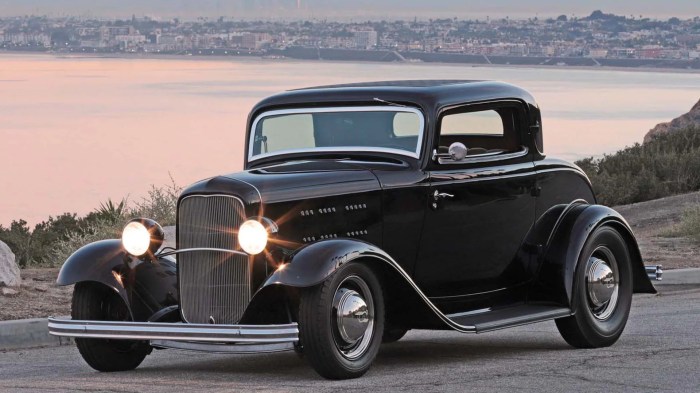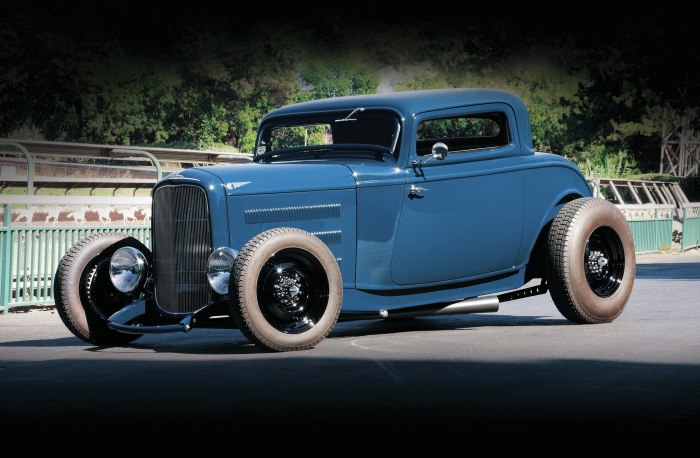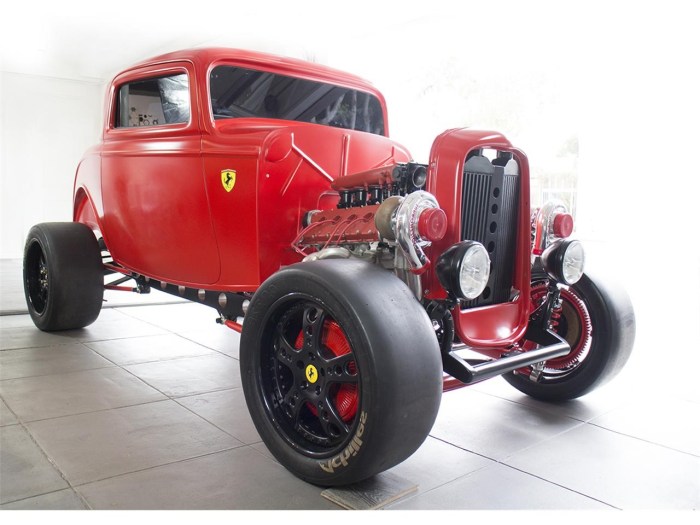The 1932 Ford Hot Rod, a symbol of American automotive ingenuity and rebellious spirit, has captivated enthusiasts for generations. Born from the ashes of the Great Depression, the 1932 Ford became the canvas for countless hot rodders, who transformed this humble vehicle into a symbol of speed, power, and individual expression.
From its sleek, streamlined design to its adaptable chassis, the 1932 Ford provided the perfect foundation for customization. Hot rodders embraced the challenge of pushing the boundaries of performance, swapping engines, upgrading suspensions, and crafting unique body modifications that set their creations apart.
This pursuit of speed and style fueled the evolution of hot rod culture, making the 1932 Ford a timeless icon.
Historical Context

The 1932 Ford, often referred to as the “Deuce Coupe,” holds a significant position in automotive history. It wasn’t just a car; it became a symbol of the American spirit, especially during the challenging economic and social climate of the early 1930s.
Its enduring popularity and influence on car culture, particularly the hot rod movement, solidify its historical importance.The 1932 Ford’s arrival coincided with the Great Depression, a period of immense economic hardship. The demand for new cars plummeted, forcing manufacturers to focus on affordability and practicality.
The 1932 Ford, with its sleek, streamlined design and relatively low price, became an accessible choice for many Americans. This affordability also played a crucial role in the emergence of the hot rod movement.
The Birth of Hot Rod Culture, 1932 Ford Hot Rod
The economic constraints of the Great Depression fueled the development of hot rod culture. The 1932 Ford, being a relatively inexpensive and readily available car, became the ideal starting point for young enthusiasts looking to build their own customized vehicles.
The hot rod movement offered a sense of freedom and individuality during a time of economic hardship. The early hot rodders were often young men with limited resources, who took advantage of the availability of used car parts to modify their vehicles.
The modifications were focused on performance, speed, and style. They often involved swapping out engines, upgrading suspension systems, and adding custom bodywork.
- Engine Swaps:Early hot rodders sought to improve performance by swapping out the original engines with more powerful units from later model cars or even from aircraft. The Ford Flathead V8 engine, introduced in 1932, quickly became a popular choice for its durability and potential for modification.
- Suspension Upgrades:The original suspension of the 1932 Ford was designed for comfort and practicality, not performance. Hot rodders would often modify the suspension by adding lowering springs, stiffer shocks, and adjustable components to improve handling and cornering.
- Custom Bodywork:The hot rodders took pride in creating unique and eye-catching vehicles. They would often modify the bodywork by chopping the tops, adding louvers, and creating custom paint jobs. These modifications were often done by hand in garages and workshops, showcasing the ingenuity and creativity of the hot rod builders.
The hot rod movement grew in popularity throughout the 1930s, with enthusiasts gathering at drag strips and street races to showcase their creations and compete for bragging rights. The 1932 Ford became a central figure in this culture, symbolizing the spirit of innovation, ingenuity, and freedom.
The 1932 Ford Hot Rod, a classic symbol of American automotive ingenuity, embodies the spirit of speed and customization. While the Hot Rod represents a stripped-down, performance-focused approach, its contemporary, the 1951 Ford Woody Wagon , embodied a different kind of American dream – one of family adventures and classic Americana.
Both vehicles, though distinct in their purpose, share a common thread: they are icons of their respective eras, captivating car enthusiasts with their unique style and historical significance.
Design and Engineering

The 1932 Ford was a revolutionary car for its time, and its simple yet elegant design made it an ideal platform for hot rodding. The car’s basic structure, including its lightweight frame, compact engine bay, and easily modifiable body panels, provided an excellent starting point for performance enhancements.
The 1932 Ford Hot Rod, a timeless classic, represents the spirit of American automotive ingenuity. While it’s a far cry from the sleek lines of a 1932 Ford, the 1971 Ford Galaxie 500 embodies a different era of muscle car dominance.
Both cars, in their own right, capture the essence of their respective times, showcasing the evolution of American automotive design and performance.
Common Modifications
The modifications performed on 1932 Ford hot rods reflect the desire to enhance performance, handling, and aesthetics. The most common modifications include engine swaps, suspension upgrades, and body modifications.
- Engine Swaps: The original flathead V8 engine, while reliable, was relatively underpowered. Hot rodders often swapped in more powerful engines, such as the small-block Chevrolet V8, the Ford Windsor V8, or even the big-block Chevrolet V8. These engine swaps provided a significant increase in horsepower and torque, making the 1932 Ford a much faster and more thrilling car to drive.
- Suspension Upgrades: The original suspension of the 1932 Ford was designed for comfort and practicality, not high-performance driving. Hot rodders often upgraded the suspension with components designed for racing, such as coilover shocks, lowered springs, and anti-roll bars. These upgrades improved handling, cornering, and overall performance.
- Body Modifications: The body of the 1932 Ford was already sleek and aerodynamic, but hot rodders often made further modifications to enhance its appearance and performance. These modifications included chopping the top, channeling the body, adding custom fenders, and installing a variety of aftermarket accessories, such as spoilers and side pipes.
Design Comparisons
The original 1932 Ford design was characterized by its simple lines, low-slung stance, and traditional styling. Hot rodders, however, sought to transform the car into a high-performance machine with a more aggressive and modern look. The modifications made to the 1932 Ford hot rod reflect these goals.
- Engine: The original flathead V8 was replaced with a more powerful engine, typically a V8 from a later model car. This change significantly increased the car’s performance, making it much faster and more powerful.
- Suspension: The original suspension was designed for comfort, but hot rodders replaced it with a more performance-oriented setup, typically featuring coilover shocks, lowered springs, and anti-roll bars. This change improved handling and cornering ability.
- Body: The body of the 1932 Ford was already aerodynamic, but hot rodders often made further modifications to enhance its appearance and performance. These modifications included chopping the top, channeling the body, adding custom fenders, and installing a variety of aftermarket accessories, such as spoilers and side pipes.
Popular Modifications

The 1932 Ford hot rod is a classic car that has been modified in countless ways over the years. One of the most popular modifications is engine swapping, which can significantly improve performance and give the car a unique personality.
Engine Swaps
Engine swaps are a common practice among hot rod enthusiasts, as they offer a way to increase power, improve handling, and customize the car’s character. The 1932 Ford’s chassis, known for its sturdy construction, can accommodate a wide range of engines, making it a popular platform for engine swaps.
The 1932 Ford Hot Rod, a classic icon of American automotive history, embodies the spirit of customization and performance. While it represents the era of hot rods and muscle cars, its influence extends to later generations of vehicles, like the iconic 1968 Ford Bronco , which captured the adventurous spirit of off-roading.
Both vehicles share a common thread of ruggedness and a desire to push the boundaries of what’s possible, reminding us that the legacy of the 1932 Ford Hot Rod lives on in the hearts of car enthusiasts everywhere.
- Small-Block Chevrolet (SBC): This is one of the most popular engine swaps for 1932 Ford hot rods. The SBC is known for its affordability, reliability, and availability of parts. A stock 350 cubic inch SBC produces approximately 300 horsepower, but with modifications, it can easily reach over 400 horsepower.
- Ford Windsor: Another popular choice, the Ford Windsor is a powerful and reliable engine that offers good performance and is readily available. The 302 cubic inch Windsor produces around 220 horsepower in stock form, but with modifications, it can achieve over 300 horsepower.
- Ford FE Series: The Ford FE Series engines, known for their large displacement and powerful torque, are popular choices for those seeking a more traditional hot rod experience. These engines, with their distinctive design and powerful output, can easily produce over 400 horsepower.
- Chrysler Hemi: The Chrysler Hemi, renowned for its distinctive hemispherical combustion chambers, offers exceptional performance and a distinctive sound. While more expensive than other options, the Hemi provides a unique and powerful experience. A stock 426 cubic inch Hemi produces around 425 horsepower, but with modifications, it can easily reach over 500 horsepower.
Engine Swap Options
The following table provides a more detailed overview of common engine swap options, their horsepower, and their impact on performance.
| Engine | Displacement (cu. in.) | Horsepower (Stock) | Horsepower (Modified) | Impact on Performance |
|---|---|---|---|---|
| Small-Block Chevrolet (SBC) | 350 | 300 | 400+ | Excellent acceleration, good power throughout the rev range, relatively affordable. |
| Ford Windsor | 302 | 220 | 300+ | Good power and torque, relatively lightweight, readily available parts. |
| Ford FE Series | 390-428 | 300-360 | 400+ | Powerful torque, distinctive sound, traditional hot rod feel. |
| Chrysler Hemi | 426 | 425 | 500+ | Exceptional performance, unique sound, high-performance option. |
Challenges and Benefits
Each engine swap option comes with its own set of challenges and benefits.
Small-Block Chevrolet (SBC)
- Benefits: Affordable, reliable, readily available parts, good power-to-weight ratio.
- Challenges: May require some modifications to fit in the 1932 Ford chassis, can be noisy.
Ford Windsor
- Benefits: Relatively lightweight, good power and torque, readily available parts, often a good fit for the 1932 Ford chassis.
- Challenges: May require some modifications for installation, can be noisy.
Ford FE Series
- Benefits: Powerful torque, distinctive sound, traditional hot rod feel.
- Challenges: Heavier than other options, can be more difficult to install, parts may be more difficult to find.
Chrysler Hemi
- Benefits: Exceptional performance, unique sound, high-performance option.
- Challenges: Expensive, can be difficult to install, parts can be expensive.
Notable 1932 Ford Hot Rods

The 1932 Ford hot rod has left an enduring mark on automotive history, inspiring countless enthusiasts and serving as a canvas for countless modifications. Some of these cars have become legendary, their stories and features captivating generations of hot rodders.
These iconic vehicles stand as testaments to the creativity, skill, and passion of the builders who brought them to life.
The History of Iconic 1932 Ford Hot Rods
The following are some of the most notable 1932 Ford hot rods that have shaped the history of the genre:
- The “California Kid”: Built by George Barris in the 1950s, the “California Kid” was a groundbreaking hot rod that showcased the emerging trends of the era. It featured a sleek, chopped top, custom paint, and a powerful small-block Chevrolet engine. This car was a significant departure from the traditional hot rods of the time and helped to define the style of the 1950s hot rod scene.
The “California Kid” was a popular car at car shows and was even featured in a magazine article. It’s been said that the “California Kid” was the first hot rod to have a custom interior and a chopped top.
The car was sold in 2008 to a private collector and is still on display at car shows today.
- The “T-Bucket”: While not technically a 1932 Ford, the T-Bucket is a hot rod based on the 1923-1927 Ford Model T chassis. It was popularized in the 1950s and became a staple of the hot rod scene. The T-Bucket is known for its minimalist design, featuring a bare-bones chassis, a simple body, and a powerful engine.
It was a popular choice for hot rodders who wanted a car that was both powerful and affordable. The T-Bucket has been featured in numerous movies and TV shows, including “American Graffiti” and “The Dukes of Hazzard.”
- The “Gasser”: This type of hot rod emerged in the 1960s and is characterized by its high-mounted rear axle, often with a “slapper” bar, and a tall, narrow front end. The gasser was designed for drag racing, with its high-mounted rear axle providing better weight transfer and traction off the line.
Some of the most iconic Gassers were based on the 1932 Ford, including the “Big Daddy Don Garlits” and the “Cacklefest” car. Gassers were known for their loud exhaust and their ability to accelerate quickly.
- The “Deuce Coupe”: The Deuce Coupe is a popular term used to describe any 1932 Ford hot rod, but it’s also the name of a song by the Beach Boys. The song, released in 1963, helped to popularize the 1932 Ford hot rod and made it a symbol of the American hot rod culture.
The Deuce Coupe was a popular choice for hot rodders in the 1960s and 1970s, and it continues to be a popular car today.
Key Characteristics of Notable 1932 Ford Hot Rods
The following table provides an overview of the key characteristics, owners, and achievements of some of the most notable 1932 Ford hot rods:
| Hot Rod | Owner | Key Features | Achievements |
|---|---|---|---|
| “California Kid” | George Barris | Chopped top, custom paint, small-block Chevrolet engine | Popular car at car shows, featured in magazines |
| “T-Bucket” | Various | Minimalist design, bare-bones chassis, powerful engine | Popular choice for hot rodders, featured in movies and TV shows |
| “Big Daddy Don Garlits” | Don Garlits | High-mounted rear axle, “slapper” bar, tall, narrow front end | Drag racing champion, iconic gasser |
| “Cacklefest” | Various | High-mounted rear axle, “slapper” bar, tall, narrow front end | Popular gasser, known for its loud exhaust |
| “Deuce Coupe” | Various | Original 1932 Ford body, custom modifications | Popularized by the Beach Boys song, iconic hot rod |
Modern 1932 Ford Hot Rods

While the spirit of hot rodding remains unchanged, the modern era has brought significant advancements in technology and materials, leading to a new breed of 1932 Ford hot rods. These builds showcase a blend of classic styling with cutting-edge engineering, pushing the boundaries of performance and customization.
Technological Advancements and Material Innovations
Modern 1932 Ford hot rods benefit from a wealth of technological advancements and material innovations, enhancing both performance and aesthetics.
- High-Performance Engines:Modern hot rodders have access to a wide range of high-performance engines, from powerful crate engines to custom-built powerhouses. These engines deliver increased horsepower and torque, enabling blistering acceleration and top speeds. Examples include the Ford Coyote 5.0L V8, the Chevrolet LS series, and even modern turbocharged engines.
- Advanced Drivetrain Components:Modern drivetrains utilize components like six-speed manual transmissions, sophisticated automatic transmissions, and high-performance differentials, contributing to enhanced drivability and power delivery. The use of lightweight materials like aluminum and carbon fiber in these components further improves efficiency and performance.
- Modern Suspension Systems:Modern hot rods benefit from independent front suspension systems, coilover shocks, and adjustable suspension components. These advancements improve handling, ride quality, and overall driving experience.
- Lightweight Materials:Modern hot rodders use lightweight materials like aluminum, carbon fiber, and composites extensively. These materials reduce overall weight, improving acceleration, handling, and fuel efficiency.
- Advanced Electronics:Modern hot rods incorporate sophisticated electronic systems, including electronic fuel injection, traction control, and anti-lock brakes. These systems enhance performance, safety, and drivability.
Pushing the Boundaries of Customization
Modern hot rodders are constantly pushing the boundaries of customization, transforming the 1932 Ford into a canvas for their creativity.
- Unique Bodywork and Styling:Modern builds often feature custom bodywork, including chopped tops, channeled frames, and custom-made panels. These modifications create a distinctive and aggressive look.
- Interior Refinement:Modern interiors prioritize comfort and functionality. They feature custom upholstery, modern gauges, and high-quality sound systems.
- Advanced Paint and Finish:Modern hot rods showcase stunning paint finishes, from traditional hot rod colors to intricate custom paint schemes. Advanced paint technologies, including multi-stage finishes and custom airbrushing, create a show-stopping aesthetic.
Building a 1932 Ford Hot Rod

Building a 1932 Ford hot rod is a labor of love, a journey that combines mechanical skill, creative vision, and a deep appreciation for automotive history. From sourcing a chassis to meticulously crafting the final details, the process is a rewarding experience for those seeking to create a unique and powerful piece of automotive art.
Sourcing a Chassis
The foundation of any hot rod is its chassis, and for a 1932 Ford, the options are diverse. A common starting point is a reproduction chassis, offering a solid base with modern engineering and safety features. Alternatively, you can embark on a restoration project, restoring an original chassis to its former glory.
- Reproduction Chassis:These chassis are built using modern materials and manufacturing techniques, ensuring strength and durability. Popular brands include Speedway Motors, Brookville Roadster, and United Pacific. They often include features like independent front suspension, disc brakes, and a rack-and-pinion steering system for improved handling and safety.
- Original Chassis:Restoring an original chassis is a labor-intensive process, requiring meticulous attention to detail and specialized skills. This option allows for authenticity but demands considerable time and effort. The original chassis may need extensive repair, sandblasting, and powder coating to ensure longevity and a smooth finish.
Choosing a Body Style
The body style is a defining element of the 1932 Ford hot rod, shaping its overall aesthetic and character. The most popular body styles include:
- Coupe:The classic two-door coupe offers a sleek and streamlined profile, perfect for a traditional hot rod build.
- Roadster:The open-top roadster exudes a sense of freedom and vintage charm, ideal for those who prioritize a classic hot rod look.
- Sedan:The four-door sedan provides ample space for passengers and cargo, making it a practical option for a hot rod build.
- Pickup:The pickup truck offers a unique and versatile body style, perfect for a hot rod with a touch of ruggedness.
Engine Selection
The heart of any hot rod is its engine, and for a 1932 Ford, the options are endless. From classic flatheads to modern V8s, the choice depends on your desired performance and aesthetic.
- Flathead V8:The iconic flathead V8 is a classic choice for a 1932 Ford hot rod, offering a distinctive sound and a nostalgic feel. However, they can be less powerful than modern engines and require specialized knowledge for maintenance.
- Small Block Chevy:A popular choice for hot rodders, the small block Chevy offers a balance of power, reliability, and affordability. Its compact size makes it easy to fit into the engine bay of a 1932 Ford.
- Big Block Chevy:For those seeking maximum horsepower, the big block Chevy is a formidable option. Its large displacement and high-performance capabilities make it ideal for high-speed runs and drag racing.
- Ford Windsor/Cleveland:These engines offer a balance of power and reliability, with a variety of modifications available to increase their performance.
- Modern Engines:Modern engines, such as LS series engines from Chevrolet or Coyote engines from Ford, offer impressive power and efficiency. However, their installation may require significant modifications to the chassis and engine bay.
Transmission and Drivetrain
The transmission and drivetrain play a crucial role in transferring power from the engine to the wheels, influencing the hot rod’s performance and drivability.
- Manual Transmissions:Manual transmissions provide a direct connection to the engine, offering a more engaging driving experience. Popular options include Tremec, BorgWarner, and Muncie transmissions.
- Automatic Transmissions:Automatic transmissions offer convenience and ease of driving, especially in heavy traffic or stop-and-go conditions. Modern automatic transmissions, such as those from GM or Ford, offer smooth shifting and improved fuel economy.
- Rear Axle:The rear axle determines the final drive ratio, influencing the hot rod’s acceleration and top speed. Popular choices include Ford 9-inch, Dana 60, and Currie Enterprises axles.
Suspension and Brakes
The suspension and braking system ensure a safe and comfortable ride, handling, and stopping power.
- Front Suspension:A common upgrade for 1932 Ford hot rods is an independent front suspension, offering improved handling and ride quality. Popular options include Mustang II, Fatman Fabrications, and Heidts Hot Rod Components.
- Rear Suspension:The rear suspension can be modified with leaf springs, coilover shocks, or air suspension to enhance handling and ride comfort.
- Brakes:Disc brakes are a significant upgrade over the original drum brakes, providing improved stopping power and responsiveness. Popular options include Wilwood, Baer, and Brembo brakes.
Interior and Exterior
The interior and exterior of the 1932 Ford hot rod are where your personal style and vision come to life.
- Interior:The interior can be customized with custom seats, upholstery, gauges, and steering wheels to create a comfortable and stylish cockpit.
- Exterior:The exterior can be painted in a variety of colors, with custom bodywork, chrome accents, and wheels to enhance the hot rod’s aesthetic appeal.
Assembly and Finishing
The final stage involves assembling all the components and finishing the hot rod to your specifications.
- Assembly:The assembly process requires careful attention to detail, ensuring all components are properly installed and aligned.
- Finishing:The finishing touches include painting, detailing, and adding any final touches to create a unique and impressive hot rod.
The Cultural Impact: 1932 Ford Hot Rod

The 1932 Ford hot rod has transcended its status as a mere vehicle, becoming a cultural icon that has profoundly shaped automotive trends, fueled a passionate community, and left an enduring legacy on car culture worldwide. The 1932 Ford hot rod’s influence extends beyond its impact on car culture, inspiring numerous automotive trends and designs.
Its streamlined, minimalist aesthetic, combined with its performance potential, laid the groundwork for future generations of hot rods and muscle cars. The iconic design elements, such as the chopped top, louvered hood, and wide rear tires, have been adopted and reinterpreted by countless manufacturers, influencing the design of everything from sports cars to concept vehicles.
The Evolution of Hot Rod Culture
The 1932 Ford hot rod played a pivotal role in the evolution of hot rod culture, acting as a catalyst for its growth and development.
- Early Days (1930s-1940s):The 1932 Ford was a popular choice for early hot rodders due to its affordability, accessibility, and ease of modification. The hot rod scene was primarily focused on performance and customization, with enthusiasts modifying their cars for speed and drag racing.
The 1932 Ford became synonymous with hot rodding, establishing its iconic status.
- Post-War Boom (1950s-1960s):The post-war period witnessed a surge in popularity for hot rods, with the 1932 Ford remaining a favorite among enthusiasts. The development of new technologies, such as the V8 engine and the rear suspension, further fueled the hot rod movement.
This era also saw the rise of hot rod magazines and car shows, further solidifying the 1932 Ford’s place in automotive culture.
- Modern Era (1970s-Present):The hot rod culture continues to evolve, with the 1932 Ford remaining a symbol of American automotive ingenuity. Modern hot rodders have embraced new technologies and materials, while still retaining the core principles of performance and customization. The 1932 Ford has inspired numerous modern interpretations, showcasing the enduring appeal of its classic design and performance potential.
Ending Remarks

The legacy of the 1932 Ford Hot Rod continues to inspire and influence automotive culture today. From the iconic builds that graced the pages of hot rod magazines to the modern interpretations that push the limits of performance and aesthetics, the 1932 Ford remains a testament to the enduring spirit of hot rodding.
Its ability to blend classic styling with modern technology ensures that this legendary vehicle will continue to captivate enthusiasts for generations to come.